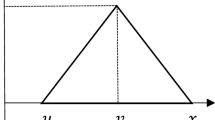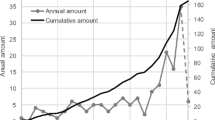Abstract
Two-stage data envelopment analysis (TsDEA) models evaluate the performance of a set of production systems in which each system includes two operational stages. Taking into account the internal structures is commonly found in many situations such as seller-buyer supply chain, health care provision and environmental management. Contrary to conventional DEA models as a black-box structure, TsDEA provides further insight into sources of inefficiencies and a more informative basis for performance evaluation. In addition, ignoring the qualitative and imprecise data leads to distorted evaluations, both for the subunits and the system efficiency. We present the fuzzy input and output-oriented TsDEA models to calculate the global and pure technical efficiencies of a system and sub-processes when some data are fuzzy. To this end, we propose a possibilistic programming problem and then convert it into a deterministic interval programming problem using the α-level based method. The proposed method preserves the link between two stages in the sense that the total efficiency of the system is equal to the product of the efficiencies derived from two stages. In addition to the study of technical efficiency, this research includes two further contributions to the ancillary literature; firstly, we minutely discuss the efficiency decompositions to indicate the sources of inefficiency and secondly, we present a method for ranking the efficient units in a fuzzy environment. An empirical illustration is also utilised to show the applicability of the proposed technique.

Similar content being viewed by others
Notes
The overview of fuzzy sets theory and fuzzy numbers are briefly provided in “Appendix 1”.
References
Agrell PJ, Hatami-Marbini A (2013) Frontier-based performance analysis models for supply chain management: state of the art and research directions. Comput Ind Eng 66(3):567–583
Aigner D, Lovell CK, Schmidt P (1977) Formulation and estimation of stochastic frontier production function models. J Econom 6(1):21–37
Amirteimoori A (2013) A DEA two-stage decision processes with shared resources. Cent Eur J Operat Res 21(1):141–151
Andersen P, Petersen N (1993) A procedure for ranking efficient units in data envelopment analysis. Manage Sci 39:1261–1264
Charnes A, Cooper WW, Rhodes E (1978) Measuring the efficiency of decision making units. Eur J Operat Res 2:429–444
Cooper WW, Park KS, Yu G (1999) IDEA and AR-IDEA: models for dealing with imprecise data in DEA. Manag Sci 45(4):597–607
Emrouznejad A, Tavana M, Hatami-Marbini A (2014) The state of the art in fuzzy data envelopment analysis, in: Performance measurement with fuzzy data envelopment analysis, Studies in fuzziness and soft computing, Springer, vol 309, pp 1–45
Färe R, Grosskopf S (2000) Network DEA. Soc Econ Plan Sci 34:35–49
Färe R, Primont D (1984) Efficiency measures for multiplant firms. Operat Res Lett 3(5):257–260
Hatami-Marbini A, Emrouznejad A, Tavana M (2011) A taxonomy and review of the fuzzy data envelopment analysis literature: two decades in the making. Eur J Operat Res 214(3):457–472
Hatami-Marbini A, Ebrahimnejad A, Lozano S (2017) Fuzzy efficiency measures in data envelopment analysis using lexicographic multiobjective approach. Comput Ind Eng 105:362–376
Kao C (2009) Efficiency measurement for parallel production systems. Eur J Operat Res 196(3):1107–1112
Kao C (2012) Efficiency decomposition for parallel production systems. Eur J Operat Res 63(1):64–71
Kao C, Hwang SN (2008) Efficiency decomposition in two-stage data envelopment analysis: an application to non-life insurance companies in Taiwan. Eur J Operat Res 185(1):418–429
Kao C, Hwang SN (2011) Decomposition of technical and scale efficiencies in two-stage production systems. Eur J Operat Res 211(3):515–519
Kao C, Lin PH (2012) Efficiency of parallel production systems with fuzzy data. Fuzzy Sets Syst 198:83–98
Kao C, Liu ST (2000) Fuzzy efficiency measures in data envelopment analysis. Fuzzy Sets Syst 113(3):427–437
Kao C, Liu ST (2011) Efficiencies of two-stage systems with fuzzy data. Fuzzy Sets Syst 176(1):20–35
Land KC, Lovell CA, Thore S (1993) Chance-constrained data envelopment analysis. Manag Decis Econ 14(6):541–554
Lertworasirikul S, Fang SC, Joines JA, Nuttle HLW (2003) Fuzzy data envelopment analysis (DEA): a possibility approach. Fuzzy Sets Syst 139(2):379–394
Liu ST (2014a) Fuzzy efficiency ranking in fuzzy two-stage data envelopment analysis. Optim Lett 8(2):633–652
Liu ST (2014b) Restricting weight flexibility in fuzzy two-stage DEA. Comput Ind Eng 74:149–160
Lozano S (2014a) Process efficiency of two-stage systems with fuzzy data. Fuzzy Sets Syst 243:36–49
Lozano S (2014b) Computing fuzzy process efficiency in parallel systems. Fuzzy Optim Decis Mak 13(1):73–89
Meeusen W, van Den Broeck J (1977) Efficiency estimation from Cobb-Douglas production functions with composed error. Int Econ Rev 435–444
Nguyen HT (1978) A note on the extension principle for fuzzy sets. J Math Anal Appl 64(2):369–380
Olesen OB, Petersen NC (2016) Stochastic data envelopment analysis—A review. Eur J Oper Res 251(1):2–21
Ruiz JL, Sirvent I (2017) Fuzzy cross-efficiency evaluation: a possibility approach. Fuzzy Optim Decis Mak 16(1):111–126
Saati SM, Memariani A, Jahanshahloo GR (2002) Efficiency analysis and ranking of DMUs with fuzzy data. Fuzzy Optim Decis Mak 1(3):255–267
Seiford LM, Zhu J (1999) Profitability and marketability of the top 55 US commercial banks. Manag Sci 45(9):1270–1288
Sengupta JK (1992) A fuzzy systems approach in data envelopment analysis. Comput Math Appl 24(8–9):259–266
Wen M, Qin Z, Kang R (2011) Sensitivity and stability analysis in fuzzy data envelopment analysis. Fuzzy Optim Decis Mak 10(1):1–10
Yu MM, Chen PC (2011) Measuring air routes performance using a fractional network data envelopment analysis model. Cent Eur J Operat Res 19(1):81–98
Zadeh LA (1978) Fuzzy sets as a basis for a theory of possibility. Fuzzy Sets Syst 1:3–28
Zimmermann HJ (1996) Fuzzy set theory-and its applications, 3rd edn. Kluwer Academic, Boston
Author information
Authors and Affiliations
Corresponding author
Appendix 1. Fuzzy sets theory
Appendix 1. Fuzzy sets theory
This appendix reviews some basic definitions of fuzzy sets theory and fuzzy numbers (Zimmermann 1996).
Let U be a universe set. A fuzzy set \( \tilde{M} \) in the universe set U is defined by the membership function \( \mu_{{\tilde{M}}} \left( x \right) \to \left[ {0,1} \right] \) where \( \forall x \in U \to \mu_{{\tilde{M}}} \left( x \right) \) stands for the grade of membership of \( \tilde{M} \) in U. A fuzzy subset \( \tilde{M} \) is said to be normal and convex if \( \mathop {\sup }\limits_{x \in U} \mu_{{\tilde{M}}} \left( x \right) = 1 \) and \( \mu_{{\tilde{M}}} \left( {\lambda x + \left( {1 - \lambda } \right)y} \right) \ge \left( {\mu_{{\tilde{M}}} \left( x \right) \wedge \mu_{{\tilde{M}}} \left( y \right)} \right), \forall x,y \in U, \forall \lambda \in \left[ {0,1} \right] \), respectively, where \( \wedge \) is the minimum operator. A fuzzy number is a normal and convex fuzzy subset with a given membership whose grade varies between 0 and 1. A triangular fuzzy number, denoted as \( \tilde{M} = \left( {l,m,u} \right) \), is the most widely used fuzzy numbers in practice and theory with the following membership function:
Note that a crisp number M is a special case of the triangular fuzzy number in which \( l = m = u. \)
Rights and permissions
About this article
Cite this article
Hatami-Marbini, A., Saati, S. & Sajadi, S.M. Efficiency analysis in two-stage structures using fuzzy data envelopment analysis. Cent Eur J Oper Res 26, 909–932 (2018). https://doi.org/10.1007/s10100-018-0545-8
Published:
Issue Date:
DOI: https://doi.org/10.1007/s10100-018-0545-8




